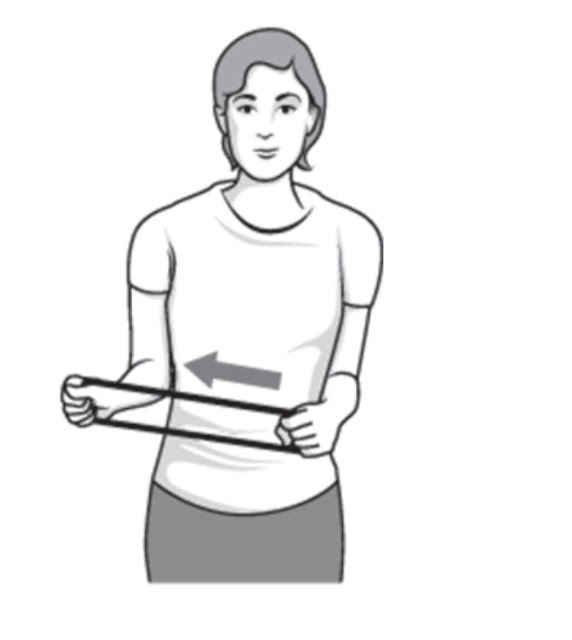Adhesive capsulitis (Frozen shoulder)
The condition may occur more commonly in people with diabetes and in people who've kept their arm immobilised for a long period of time. Adhesive capsulitis is also known as frozen shoulder. Frozen shoulder is a painful condition in which the shoulder becomes stiff and inflamed, and movement becomes limited.
Sign and symptoms of frozen shoulder-
Frozen shoulder occurs when the strong connective tissue surrounding the shoulder joint (called the shoulder joint capsule) become thick, stiff, and inflamed. The joint capsule contains the ligaments that attach the top of the upper arm bone (humeral head) to the the shoulder socket (glenoid), firmly holding the joint in place. This is more commonly known as the "ball and socket" joint.
The condition is called "frozen shoulder" because the more pain that is felt, the less likely the shoulder will be used. Lack of use causes the shoulder capsule to thicken and becomes tight, making the shoulder even more difficult to move- it is "frozen" in the position.
Sign and symptoms of frozen shoulder-
Symptoms of frozen shoulder are divided into three stages:
- The "freezing stage: The shoulder becomes stiff and is painful to move. The pain slowly increases. It may worsen at night. Inability to move the shoulder increases. This stage lasts 6 weeks to 9 months.
- The "frozen" stage: Pain may lessen, but the shoulder remains stiff. This makes it more difficult to complete daily tasks and activities. This stage lasts 2 to 6 months.
- The "thawing" (recovery) stage: Pain lessens, and ability to move the shoulder slowly improves. Full or near full recovery occurs as normal strength and motion return. The stage lasts 6 months to 2 years.
Here are some exercises for adhes ive capsulitis (frozen shoulder)
Relax your shoulders. Stand and lean over slightly, allowing the affected arm to hang down. Swing the arm in a small circle- about a foot in diameter. Perform 10 revolutions in each direction, once a day. As your symptoms improve, increase the diameter of your swing, but never force it. When you're ready for more, increase the stretch by holding a light weight (three to five pounds) in the swinging arm.
2.Towel stretch
Hold one end of a three-foot-towel behind your back and grab the opposite end with your other hand.Hold the towel in horizontal position. Use your good arm to pull the affected arm upward to stretch it. You can also do an advanced version of this exercise with the towel draped over your good shoulder. Hold the bottom of the towel with the affected arm and pull it toward the lower back with unaffected arm. Do this 10-15 times a day.
3. Finger walk
Face a wall three -quaters of an arm's length away. Reach out and touch the wall at the waist level with the fingertips of affected arm. With your elbow slightly bent, slowly walk your fingers up the wall, spider-like, until you've raised your arm as far as you comfortably can. Your fingers should be doing the work, not your shoulder muscles. Slowly lower the arm (with the help of the good arm, if necessary) and repeat. Perform this exercise 10-20 times a day.
4. Cross-body reach
Sit or stand. Use your good arm to lift your affected arm to the elbow, and bring it up and across your body, exerting gentle pressure to stretch the shoulder. Hold the stretch for 15-20 seconds. Do this 10-20 times per day.
5. Armpit stretch
Using your good arm, lift the affected arm onto a shelf about breast-high. Gently bend your knees, opening up the armpit. Deepen your knees, slightly, gently stretching the armpit, and then straighten. With each knee bend, stretch a little further, but don't force it. Do it 10-15 times a day.
6. Outward rotation
Hold a resistance band between your hands with elbows at a 90-degree angle close to your sides. Rotate the lower part of the affected arm outward two or three inches and hold for five seconds. Repeat 10-15 times, once a day.
7. Inward rotation
Stand next to a closed door, and hook one end of a resistance around the doorknob. Hold the other end with the hand of the affected arm, holding your elbow at a 90-degree angle. Pull the band toward your body two or three inches and hold for five seconds. Repeat 10-15 times, once a day.
8. Wand exercise
exercise: Flexion:
Stand upright and hold a stick in both hands, palms down. Stretch your arms by lifting them over your head, keeping your elbows straight. Hold for 5 seconds and return to the starting position. Repeat 10 times.9. Static exercise
In standing position, place yourself, facing in a corner between the door and wall. Place one arm on the door and one arm on the wall, with your shoulders and elbows flexed at 90 degrees. Now, lean into the corner and you should feel a stretch across your chest. Hold for 20-30 seconds and repeat for 3-6 reps
In the guidance of,
Dr Rajesh Gautum (PT)
References
1. frozen shoulder
https://www.physio-pedia.com/Adhesive_Capsulitis#share
2.https://my.clevelandclinic.org/health/diseases/15359-frozen-shoulder
3.https://www.mayoclinic.org/diseases-conditions/frozen-shoulder/symptoms-causes/syc-20372684
4. https://en.wikipedia.org/wiki/Adhesive_capsulitis_of_the_shoulder










Very helpful and informative
ReplyDeleteThank you
DeleteThank you
ReplyDelete